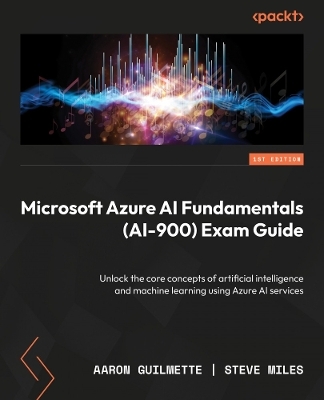
Microsoft Azure AI Fundamentals AI-900 Exam Guide
Packt Publishing Limited (Verlag)
978-1-83588-566-6 (ISBN)
- Titel nicht im Sortiment
- Artikel merken
Key Features
Discover Azure AI services, including computer vision, Auto ML, NLP, and OpenAI
Explore AI use cases, such as image identification, chatbots, and more
Work through 145 practice questions under chapter-end self-assessments and mock exams
Purchase of this book unlocks access to web-based exam prep resources, including mock exams, flashcards, and exam tips
Book DescriptionThe AI-900 exam helps you take your first step into an AI-shaped future. Regardless of your technical background, this book will help you test your understanding of the key AI-related topics and tools used to develop AI solutions in Azure cloud.
This exam guide focuses on AI workloads, including natural language processing (NLP) and large language models (LLMs). You’ll explore Microsoft’s responsible AI principles like safety and accountability. Then, you’ll cover the basics of machine learning (ML), including classification and deep learning, and learn how to use training and validation datasets with Azure ML. Using Azure AI Vision, face detection, and Video Indexer services, you’ll get up to speed with computer vision-related topics like image classification, object detection, and facial detection. Later chapters cover NLP features such as key phrase extraction, sentiment analysis, and speech processing using Azure AI Language, speech, and translator services. The book also guides you through identifying GenAI models and leveraging Azure OpenAI Service for content generation. At the end of each chapter, you’ll find chapter review questions with answers, provided as an online resource.
By the end of this exam guide, you’ll be able to work with AI solutions in Azure and pass the AI-900 exam using the online exam prep resources.What you will learn
Discover various types of artificial intelligence (AI)workloads and services in Azure
Cover Microsoft's guiding principles for responsible AI development and use
Understand the fundamental principles of how AI and machine learning work
Explore how AI models can recognize content in images and documents
Gain insights into the features and use cases for natural language processing
Explore the capabilities of generative AI services
Who this book is forWhether you're a cloud engineer, software developer, an aspiring data scientist, or simply interested in learning AI/ML concepts and capabilities on Azure, this book is for you. The book also serves as a foundation for those looking to attempt more advanced AI and data science-related certification exams (e.g. Microsoft Certified: Azure AI Engineer Associate). Although no experience in data science and software engineering is required, basic knowledge of cloud concepts and client-server applications is assumed.
Aaron Guilmette is a Principal Architect at Planet Technologies, an award-winning Microsoft Partner focused on the Public Sector. As an author of over a dozen IT books, he specializes in identity, messaging, and automation technologies. Previous to Planet Technologies, Aaron was a Senior Program Manager for Microsoft focusing on Microsoft 365 Customer Experience. When he's not writing books or tools for his customers, Aaron can be found tinkering on cars. Steve Miles works in a technology leadership role for the cloud practice of a multi-billion turnover IT distributor based in the UK and Ireland. He is a Microsoft Azure MVP (Most Valuable Professional), MCT (Microsoft Certified Trainer) and Microsoft technologies author. Steve has more than 25 years of experience in hosted datacenter services, hybrid, and multi-cloud platforms. In his free time, Steve also can be found tinkering on cars. Peter De Tender has 20 years of professional expertise in Microsoft Infrastructure consulting and architecting, with a main focus on Microsoft Cloud technologies (Azure, Enterprise Mobility Suite, Office 365...). After working for some of the top Microsoft partners in Belgium, he ran his own successful business for several years, mainly providing Infrastructure and Cloud Architect training and readiness in a passionate and enthusiastic way. Peter coached several Microsoft Partners all over the world in doing more Microsoft business, both from a technical and business angle. Just recently, as of June 2016 to be exact, Peter joined Microsoft Corp as an FTE Azure Architect and Program Manager in the global AzureCAT GSI team, part of Azure engineering, where his role consists of providing Azure-focused readiness training and cloud practice building coaching to the TOP Microsoft Global System Integrators. This role allows Peter to combine his two passions, working on the latest and greatest up-to-date technologies, and cooperating with people from all over the globe. His valued credentials are Microsoft Certified Trainer, Azure Certified Architect, and— before he joined Microsoft—Peter was also recognized as a Microsoft MVP for several years in a row. In his free time, Peter loves speaking at (inter)national conferences and community events, is a technical writer and courseware creator.
Table of Contents
Identify Features of Common AI Workloads
Identify the Guiding Principles for Responsible AI
Identify Common Machine Learning Techniques
Describe Core Machine Learning Concepts
Describe Azure Machine Learning Capabilities
Identify Common Types of Computer Vision Solutions
Identify Azure Tools and Services for Computer Vision Tasks
Identify Features of Common NLP Workload Scenarios
Identify Azure Tools and Services for NLP Workloads
Identify Features of Generative AI Solutions
Identify Capabilities of Azure OpenAI Service
| Erscheinungsdatum | 17.04.2024 |
|---|---|
| Vorwort | Peter De Tender |
| Verlagsort | Birmingham |
| Sprache | englisch |
| Maße | 191 x 235 mm |
| Themenwelt | Informatik ► Theorie / Studium ► Künstliche Intelligenz / Robotik |
| Informatik ► Weitere Themen ► Zertifizierung | |
| ISBN-10 | 1-83588-566-7 / 1835885667 |
| ISBN-13 | 978-1-83588-566-6 / 9781835885666 |
| Zustand | Neuware |
| Haben Sie eine Frage zum Produkt? |
aus dem Bereich


